Lot details Please note this Lot is to be sold at No Reserve. 本拍品不設底價 China, 1750-1850. Of rectangular form, meticulously decorated in underglaze-blue with ‘heaping and piling’, featuring nine dragons painted in iron-red amid scrolling vines issuing lingzhi fungi and lily flowers. Each dragon is shown in a different pose and with individual features: The central dragon with a bifurcated tail and biting a lingzhi fungus, flanked by two dragons, one with two horns, the other front facing. The lower row featuring a winged dragon, a dragon with a flaming tail, and another dragon with a bifurcated tail. The upper row depicting two dragons with bifurcated tails centered by a two horned dragon. All within a delicately painted key-fret border. Provenance: British trade. Condition: Very good condition with minor wear to the iron-red and manufacturing flaws including pitting, firing flaws, dark spots, and light surface scratches. The hardwood frame with expected minor age cracks and nicks. Weight: 5,1 kg Dimensions: Size 50.4 x 49.8 cm With a matching hardwood frame. (2) The number nine is considered auspicious in Chinese astrology and folk beliefs. Representing the fullest expression of yang, nine is closely associated with heaven in that it evokes infinity, partly because it was the product of three times three, the most basic unit of three being heaven, earth, and man, and partly because the number nine was homophone with the word ‘jiu’ meaning eternity. The most prestigious decorative motif for the Chinese imperial court in the Qing dynasty is the Imperial dragon - the symbol of the Son of Heaven, the Emperor himself. In this case there are nine dragons, an association for the nine sons of the Dragon King. This use of the sacred number nine reinforces the imperial connection and suggests that the piece was intended for use within the Imperial household. Literature comparison: Compare a related iron-red and underglaze-blue ‘nine dragon’ charger, Yongzheng period, sold at Sotheby’s Hong Kong, 8 October 2012, lot 125. Compare further a large cinnabar lacquer ‘nine dragon’ screen, Qianlong period, sold at Sotheby’s Hong Kong, 10 April 2008, lot 2827. Compare also a yellow-ground silk embroidered ‘nine dragons’ Kang cushion cover, circa 1800, sold at Christie’s London, 15 May 2008, lot 100. Compare a large archaistic rhinoceros’ horn ‘nine dragon’ libation cup, 17th century, sold at Christie’s London, 10 May 2011, lot 13. Compare also a pale greenish-white jade ‘nine-dragon’ brush washer, 18th century, Christie’s New York, 23 March 2012, lot 1962. 清代中期青花礬紅九龍紋屏,或爲御用 中國,1750-1850年。長方形,青花釉下彩,礬紅彩九條龍,四周纏枝花紋地。每條龍姿勢各不同,中央的龍尾巴分叉,口啣靈芝;兩側的兩條龍,一條有兩個角,另一條面向前方;下排有一條帶翅膀的龍,一條帶火焰尾巴的龍和另一條帶分叉尾巴的龍;上排描繪了兩條尾巴分叉的龍,中央是一條雙角龍。布局疏密得宜,氣势逼人。 來源:英國古玩交易。 品相:狀況非常好,鐵紅色有輕微磨損和製造缺陷,包括點蝕、燒製缺陷、黑點和輕微的表面劃痕。硬木框架與預期的輕微年齡裂縫和刻痕。 重量:5,1 公斤 尺寸:50.4 x 49.8 厘米 硬木框裝裱。(2) 數字“九”在中國占星術和民間信仰中是吉祥數字。九代表至陽,與天密切相關,它有寓意無限,也因為它是三乘三的結果,三代表天、地、人。同時,數字九 與“久”諧音,意為永恆。 清代中國宮廷最負盛名的裝飾圖案是龍——天子的象徵,即皇帝。九條龍,代表龍之九子。 神聖數字九的使用加強了與皇室的聯繫,並表明這件作品是為皇室內部使用而設計的。 文獻比較: 比較相近的清雍正青花礬紅「水波雲龍」圖折沿大盤 《大清雍正年製》款,售於香港蘇富比,2012年10月8日,lot 125。比較一件乾隆剔紅九龍屏,售於香港蘇富比,2008年4月10日,lot 2827。比較清約1800年 黃地緞繡九龍紋炕墊,售於倫敦佳士得, 2008年5月15日,lot 100。比較一件十七世紀大型九龍犀角杯,售於倫敦佳士得,2011年5月10日,lot 13。比較一件清十八世紀青白玉雕九龍紋洗,紐約佳士得,2012年3月23日,lot 1962。
Lot details Please note this Lot is to be sold at No Reserve. 本拍品不設底價 China, 1750-1850. Of rectangular form, meticulously decorated in underglaze-blue with ‘heaping and piling’, featuring nine dragons painted in iron-red amid scrolling vines issuing lingzhi fungi and lily flowers. Each dragon is shown in a different pose and with individual features: The central dragon with a bifurcated tail and biting a lingzhi fungus, flanked by two dragons, one with two horns, the other front facing. The lower row featuring a winged dragon, a dragon with a flaming tail, and another dragon with a bifurcated tail. The upper row depicting two dragons with bifurcated tails centered by a two horned dragon. All within a delicately painted key-fret border. Provenance: British trade. Condition: Very good condition with minor wear to the iron-red and manufacturing flaws including pitting, firing flaws, dark spots, and light surface scratches. The hardwood frame with expected minor age cracks and nicks. Weight: 5,1 kg Dimensions: Size 50.4 x 49.8 cm With a matching hardwood frame. (2) The number nine is considered auspicious in Chinese astrology and folk beliefs. Representing the fullest expression of yang, nine is closely associated with heaven in that it evokes infinity, partly because it was the product of three times three, the most basic unit of three being heaven, earth, and man, and partly because the number nine was homophone with the word ‘jiu’ meaning eternity. The most prestigious decorative motif for the Chinese imperial court in the Qing dynasty is the Imperial dragon - the symbol of the Son of Heaven, the Emperor himself. In this case there are nine dragons, an association for the nine sons of the Dragon King. This use of the sacred number nine reinforces the imperial connection and suggests that the piece was intended for use within the Imperial household. Literature comparison: Compare a related iron-red and underglaze-blue ‘nine dragon’ charger, Yongzheng period, sold at Sotheby’s Hong Kong, 8 October 2012, lot 125. Compare further a large cinnabar lacquer ‘nine dragon’ screen, Qianlong period, sold at Sotheby’s Hong Kong, 10 April 2008, lot 2827. Compare also a yellow-ground silk embroidered ‘nine dragons’ Kang cushion cover, circa 1800, sold at Christie’s London, 15 May 2008, lot 100. Compare a large archaistic rhinoceros’ horn ‘nine dragon’ libation cup, 17th century, sold at Christie’s London, 10 May 2011, lot 13. Compare also a pale greenish-white jade ‘nine-dragon’ brush washer, 18th century, Christie’s New York, 23 March 2012, lot 1962. 清代中期青花礬紅九龍紋屏,或爲御用 中國,1750-1850年。長方形,青花釉下彩,礬紅彩九條龍,四周纏枝花紋地。每條龍姿勢各不同,中央的龍尾巴分叉,口啣靈芝;兩側的兩條龍,一條有兩個角,另一條面向前方;下排有一條帶翅膀的龍,一條帶火焰尾巴的龍和另一條帶分叉尾巴的龍;上排描繪了兩條尾巴分叉的龍,中央是一條雙角龍。布局疏密得宜,氣势逼人。 來源:英國古玩交易。 品相:狀況非常好,鐵紅色有輕微磨損和製造缺陷,包括點蝕、燒製缺陷、黑點和輕微的表面劃痕。硬木框架與預期的輕微年齡裂縫和刻痕。 重量:5,1 公斤 尺寸:50.4 x 49.8 厘米 硬木框裝裱。(2) 數字“九”在中國占星術和民間信仰中是吉祥數字。九代表至陽,與天密切相關,它有寓意無限,也因為它是三乘三的結果,三代表天、地、人。同時,數字九 與“久”諧音,意為永恆。 清代中國宮廷最負盛名的裝飾圖案是龍——天子的象徵,即皇帝。九條龍,代表龍之九子。 神聖數字九的使用加強了與皇室的聯繫,並表明這件作品是為皇室內部使用而設計的。 文獻比較: 比較相近的清雍正青花礬紅「水波雲龍」圖折沿大盤 《大清雍正年製》款,售於香港蘇富比,2012年10月8日,lot 125。比較一件乾隆剔紅九龍屏,售於香港蘇富比,2008年4月10日,lot 2827。比較清約1800年 黃地緞繡九龍紋炕墊,售於倫敦佳士得, 2008年5月15日,lot 100。比較一件十七世紀大型九龍犀角杯,售於倫敦佳士得,2011年5月10日,lot 13。比較一件清十八世紀青白玉雕九龍紋洗,紐約佳士得,2012年3月23日,lot 1962。
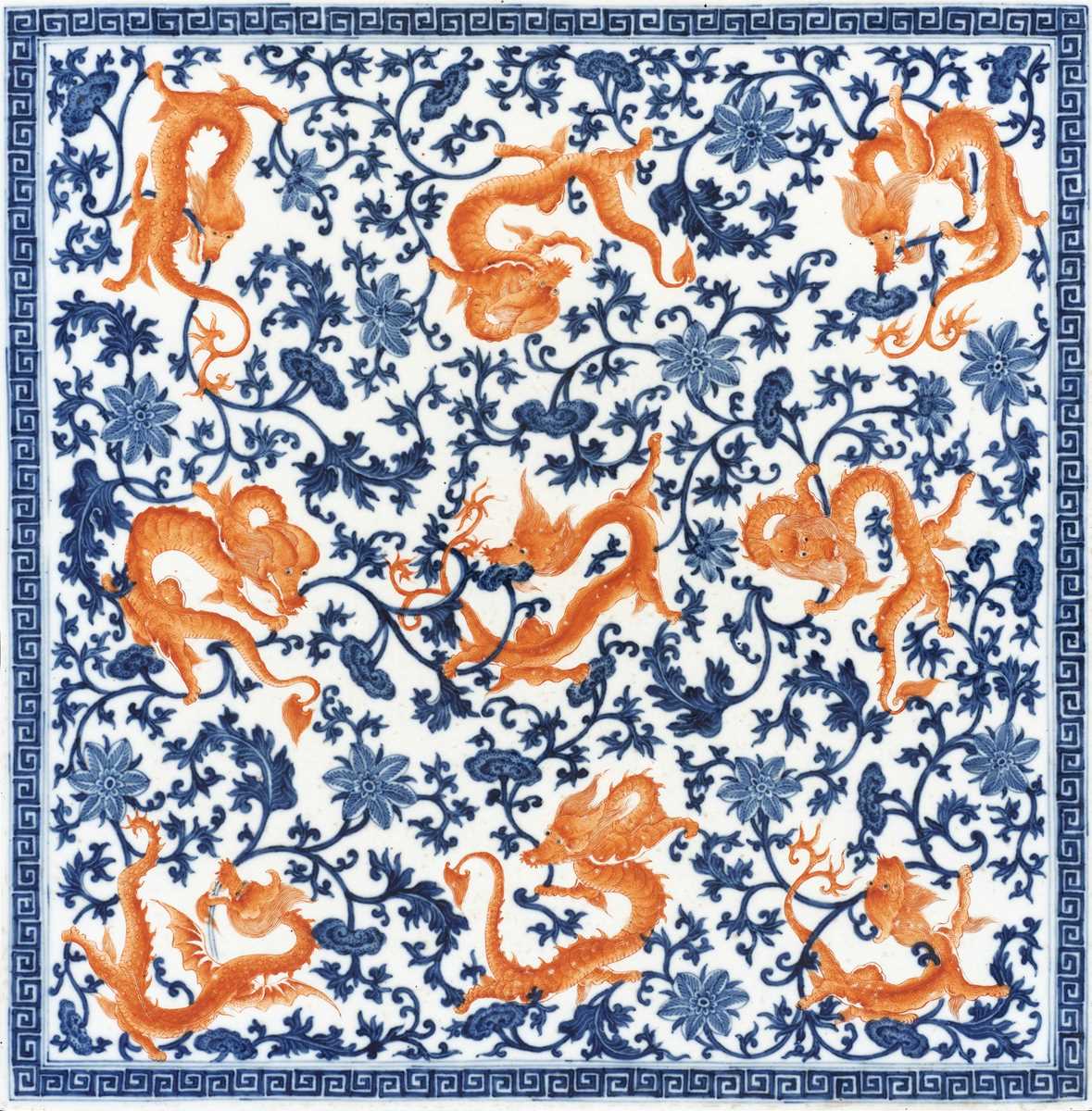
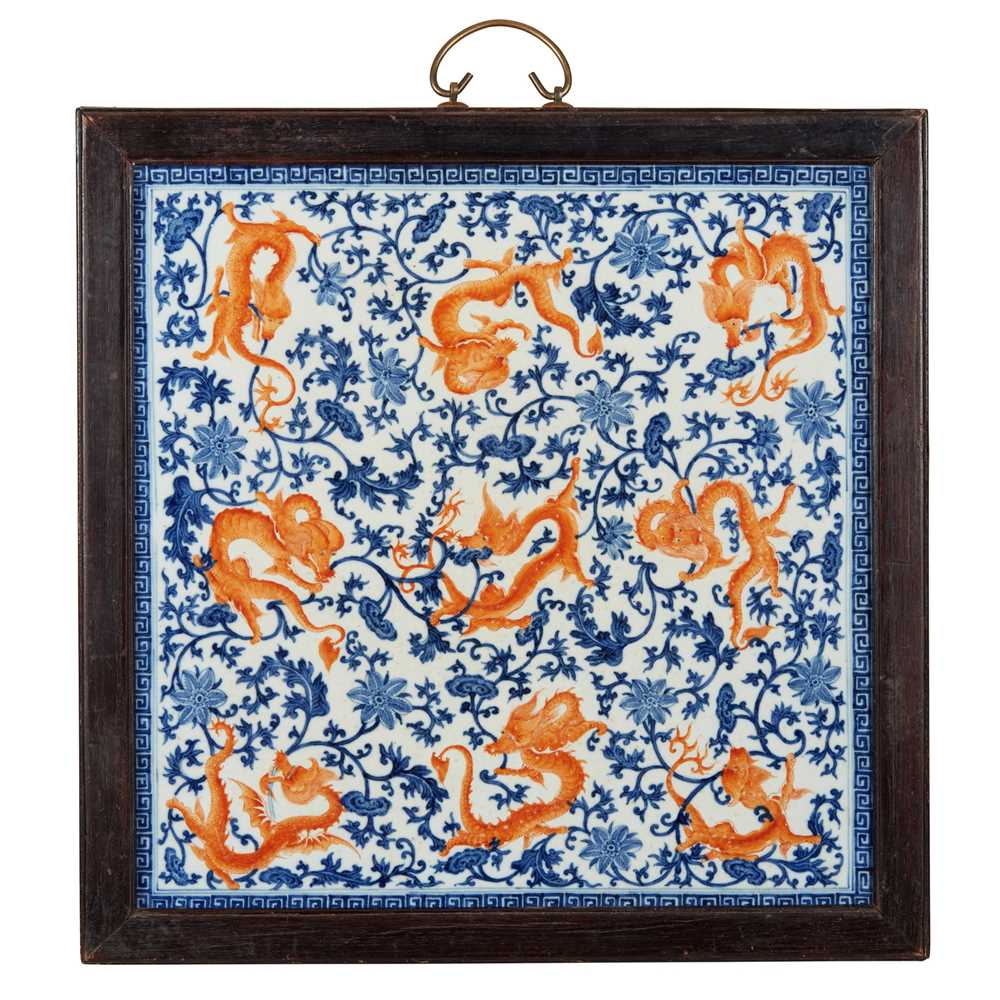

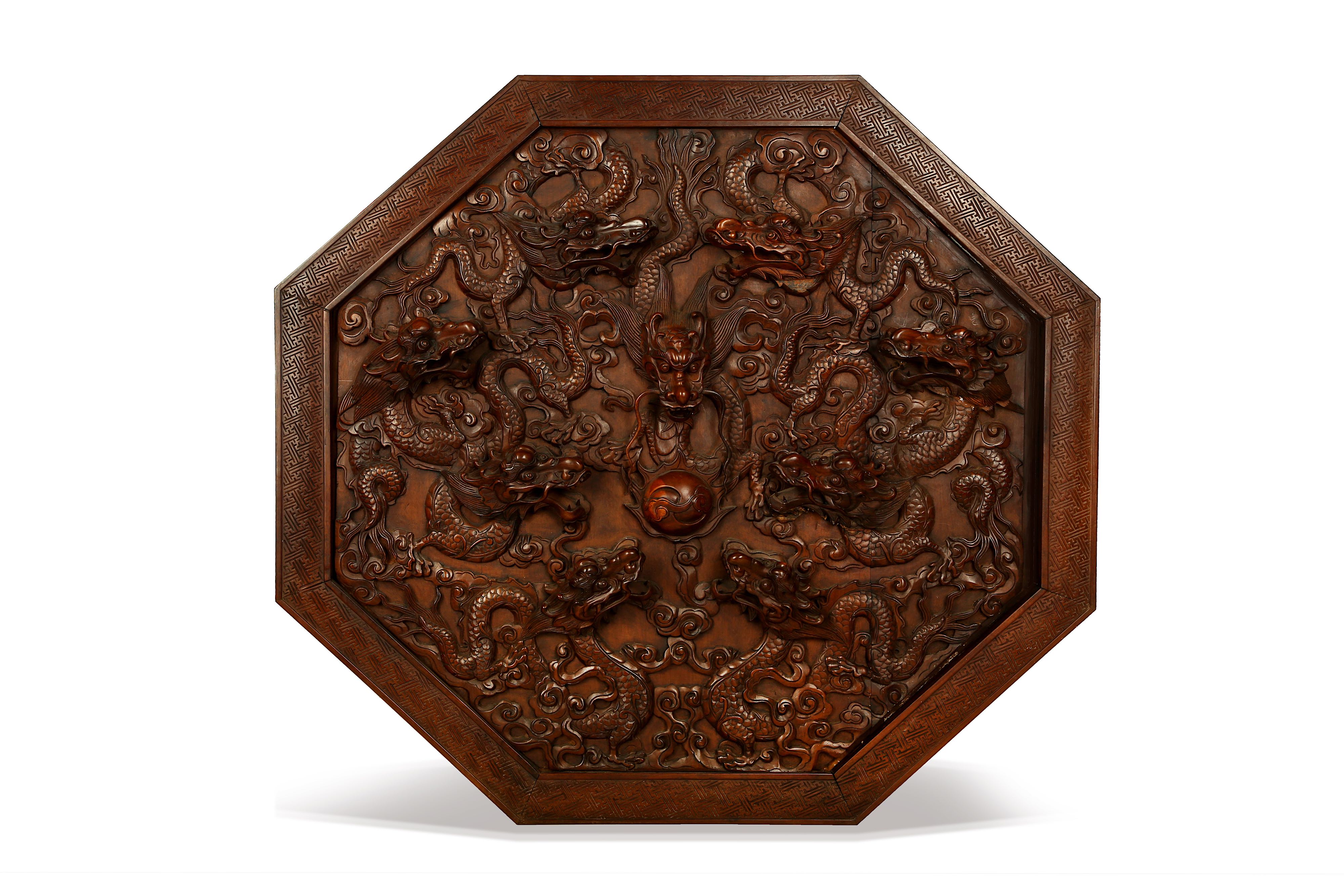
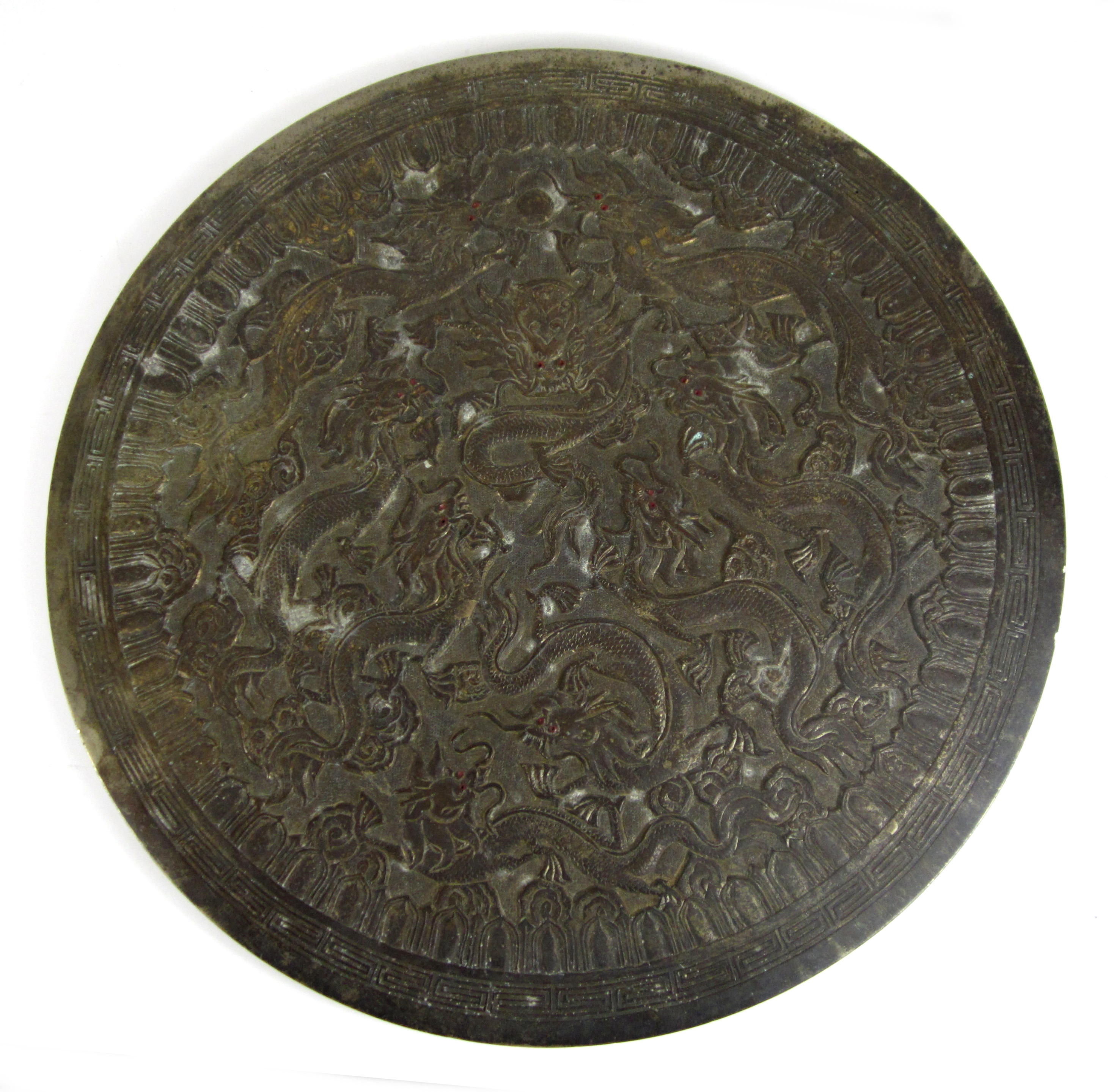

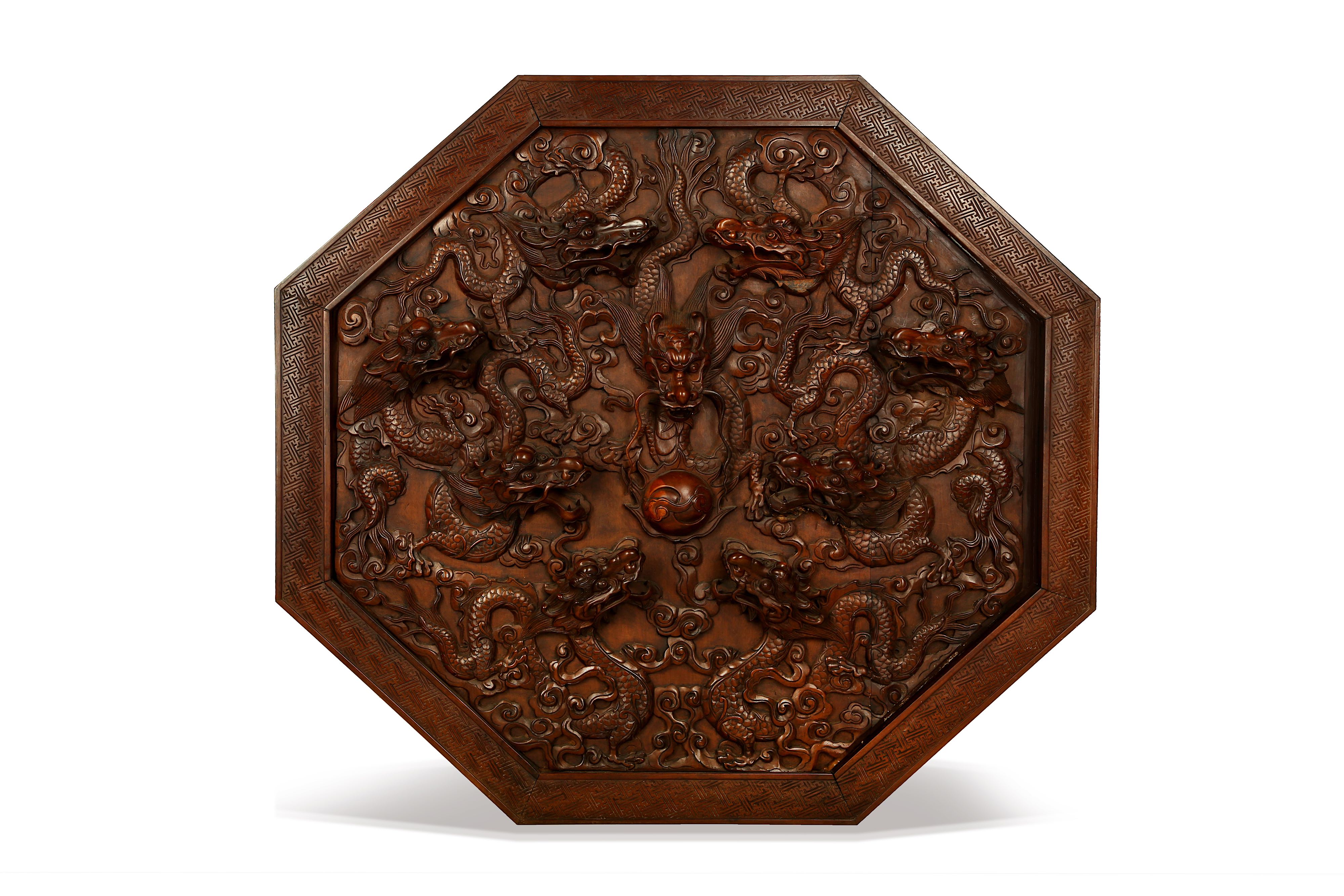






.jpg)
Testen Sie LotSearch und seine Premium-Features 7 Tage - ohne Kosten!
Lassen Sie sich automatisch über neue Objekte in kommenden Auktionen benachrichtigen.
Suchauftrag anlegen